Wildfires, a four-star general and a sold-out conference headlined the 24th AMOS Conference held September 19-22 at the Wailea Beach Resort, Maui. The premier technical conference in the nation devoted to Space Domain Awareness hosted 1082 in-person attendees from 22 countries with a further 269 participating virtually.
The conference began with a solemn note and a cultural blessing acknowledging the devastation by the August 8 wildfires that created a shadow over proceedings.
“Our 24th year has brought new challenges, new opportunities, new faces, and many familiar ones that make up our ever-growing AMOS ‘ohana,” said Leslie Wilkins, MEDB President and CEO, in her opening address. “We appreciate the support of those who showed up to support Maui and are grateful for the outpouring of Aloha.”
The AMOS Conference program featured daily Keynote speakers, SSA/SDA policy forums, exhibits, short courses and networking receptions. Both in-person and livestream attendees had access to a virtual platform to facilitate networking and collaboration before, during and after the conference.
With many requests from the AMOS community to support Maui in the recovery from the wildfires, an AMOS for Maui Fund was established. Just over $5,000 was raised directly with 100% of Funds raised to go to Hawaii Community Foundations’ Maui Strong Fund. Large donations were also made directly to Maui Strong Fund and a number of participants and their partners volunteered their time during their stay on Maui.
KEYNOTES AND POLICY FORUMS
Day 1
General B. Chance Saltzman, Chief of Space Operations, United States Space Force, presented the opening keynote. He started off by sharing the meeting he had the day before with the Maui Tech Hui that includes the 15th Space Surveillance Squadron (15SPSS), a number of industry partners and commercial startups who had deployed starlink terminals to the westside in response to the wildfires. “The terminals served to not only provide power and communications and also helped first responders with communications support and thereby helped nearby residents with charging stations, even refrigerator and freezing capability off the truck-mounted terminals.”
Saltzman spoke of the world class observatory atop Haleakala supporting space missions and space control, space sustainability and other related fields. “In addition to being called the ‘neighborhood watch’ of space, the 15SPSS is committed to being good neighbors of Maui.”
Touching on the topic of collaboration that became a theme through the conference, Saltzman said, “As we continue to build and prepare for future competition in space, there’s no question that the viability of our efforts rest on our ability to build a coalition; to uphold and strengthen a rules-based international order for space.”
“Success in space domain is the ultimate team sport and partnerships are critical to that success,” said Saltzman. “In particular, success in the space domain also requires comprehensive, actionable space domain awareness. We must understand what’s happening in space to ensure safe operations while simultaneously monitoring for behaviors that are irresponsible, even hostile. Any conflict in space has global ramifications. Space Domain Awareness must be a collective effort.”
Asked about interoperability, Saltzmann replied, “I’m not sure the government knows enough to take the lead on it without direct collaboration from industry.
“I have to involve them,” he continued. “They have to be part of the discussion, they have to see what the possibilities are, they have to have access to the industrial base that they have and that I have so that we can keep talking about these interoperable standards.
“I want to lead the discussion, but I don’t want to lead the answer. If we collectively make these decisions there will be a lot faster buy-in and it will truly be interoperable.”
Victoria Samson, Washington Office Director for Secure World Foundation (SWF) led the SSA Policy Forum on Day 1, ‘Evolution of the Commercial SSA Data Market.’ She was joined by panelists, Shreyas Mirji, Vice President, Business and Strategy, Digantara; Mahhad Nayyer, Graduate Research Assistant, Purdue University; Kevin O’Connell, Principal, Space Economy Rising; and Audrey Schaffer, Vice President, Policy and Strategy, Slingshot Aerospace.
This panel discussed how the commercial SSA sector is evolving and what the challenges are for future growth, including identifying customers and standards for data sharing as well as the balance between the role of the government and private sector in ensuring safety of spaceflight activities.
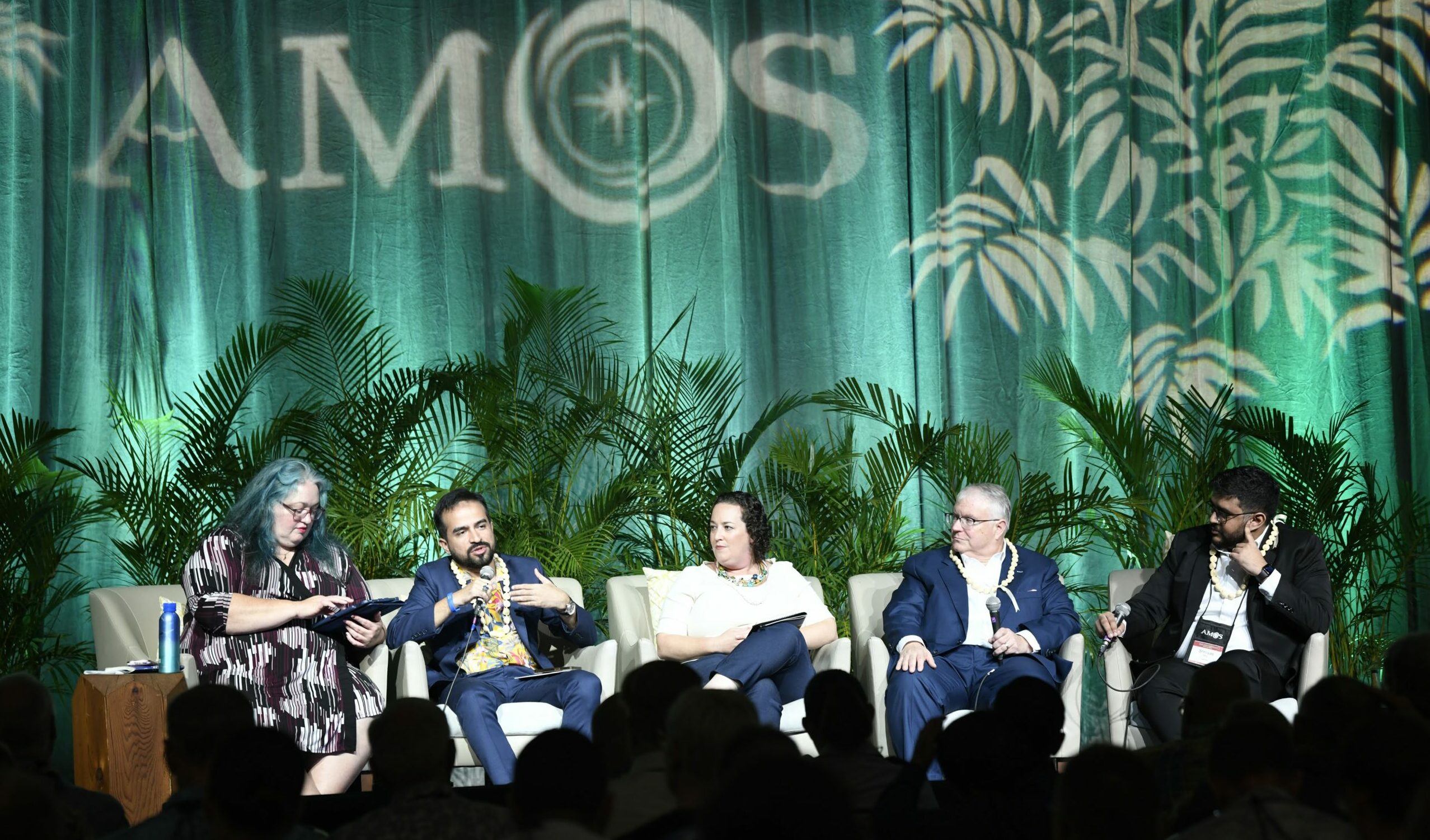
Kevin O’Connell remarked, “There’s much more attention to the problem – space safety, space sustainability and I would add a third – you know we often focus on space debris here at AMOS but I would offer another piece of this, which is a tremendous opportunity to come in the space economy — in-orbit servicing and things like that. So while we need to deal with the safety thing of this first, right behind it is the opportunity that is going to be created, and it’s where space domain awareness is going to be needed to satisfy that mission as well.”
Mahhad Nayer of Pakistan, a country that is still developing its space capabilities contributed, “Emerging space economies don’t have the access to the market or to the opportunities that developed space countries have. We really have to find a link or the niche where developing space economies or emerging countries can go with a collaborative business proposal and help the SSA community.”
“On a technical side, we know that the number of sensors is not enough, the number of geographic locations we have those sensors is not enough, and the number of satellites are increasing exponentially, so in order to have a safe and reliable STM we do need more geographically diverse locations for sensors and that is where the business opportunity is.”
Day 2
Day 2 kicked off with a keynote presentation by Diane Howard, Director of Commercial Space Policy, National Space Council.
Howard was unable to attend in-person and instead was brought in virtually to both the conference ballroom and the online platform. She provided an overview of U.S. government’s efforts in civil SSA and space traffic coordination from the vantage point of the administration’s objectives and priorities.
“Space operations are increasingly impacted by mounting congestion and unpredictability in space,” said Howard. “We must consider whether and how regulatory measures can ensure the sustainability of space for future generations. The AMOS community is key to the success – the capabilities and expertise represented on Maui this week is what we will depend upon to retain and maintain more sustainable and coordinated space activities.”
Jamie Morin, Vice President of Defense Systems Operations and Executive Director of the Center for Space Policy and Strategy, The Aerospace Corporation; moderated the Day 2 SSA Policy Forum ‘U.S. Progress on Civil SSA and STM’ with a hybrid panel. He was joined onstage by Travis Blake, Space Traffic Coordination Program Officer, NASA; and Barbara Golf, Strategic Advisor for Space Domain Awareness, U.S. Space Force. They were joined virtually by Richard DalBello, Director, Office of Space Commerce, NOAA, Department of Commerce; and Travis Langster, Principal Director, Space and Missile Defense Policy, U.S. Department of Defense.
The speakers, representing U.S. agencies involved in implementing SPD-3, provided updates on what progress has been made so far and plans for the future.
DalBello offered, “Where we are now in the discussions is how does our budget match the aspirations for providing the kinds of coverage that we’d like. A lot of that will depend on the pathfinders to determine where is the market price because there isn’t today a robust enough market that that price is obvious.”
“One of the things I’m concerned about is if we end up picking a side in industries,” commented Barbara Golf. “I don’t want us looking at something and saying like ‘the on-orbit satellite is more important than the growth of the SDA, sensors and analytic industry. What I’m really hoping that we focus on is what is the bare minimum required for space flight safety, and that the government isn’t more involved than it has to be. This enables all industries to grow into that space.”
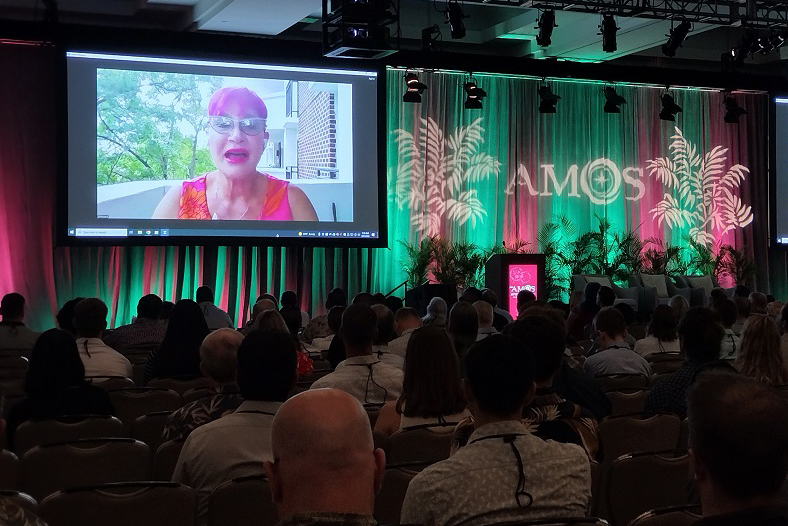
Diane Howard, National Space Council, presented the Keynote on Day 3 of the 2023 AMOS Conference

Policy Forum on Day 2 featured on-stage L. to R. Moderator Jamie Morin, Barbara Golf and Travis Blake

Richard Dalbello, U.S. Dept of Commerce and Travis Langster, U.S. Dept of Defense zoomed in for the Policy Forum at AMOS 2023
Day 3
Elizabeth Pearce, acting Director Space Technology, Office of the CTO Australian Space Agency provided the keynote on Day 3 and started off with an explanation of the Australian Space Agency logo, incorporating constellations of indigenous Australians – acknowledged as the world’s oldest astronomers.
Pearce shared the agency’s priorities, explaining, “They take a theme of developing our national space capability and national space policy so that we have a national and whole-of-government approach to how we do space. Then we want to take that, and we want to engage with all you in the room and those around the room who may be watching virtually. We want to engage internationally – there is a lot we can learn from you and a lot we can share with you.”
Continuing on the theme of collaboration, Pearce added, “It’s become clear very quickly that, as Australia we are a very big country, and to cover that land we need a lot of sensors and also a diverse range of sensors. There is no one capability that is going to solve our problem. We need it all, and we need more, and we need it all to work together. So we need to come at this from a national perspective; our industry need to join together, be united, and then that can provide a united front to the international market.”
The third and final SSA Policy Forum was moderated by Brian Weeden discussing “Moving from Industry Best Practices to Space Traffic Management Rules.” Weeden was joined onstage by Jerome Barbier, Head of Outer Space, Digital, and Economic Issues, Paris Peace Forum; Mariel Borowitz, Office of Space Commerce; David Goldstein, Principal Engineer, SpaceX; Daniel Oltrogge, Founder and Administrator, Space Safety Coalition.
Introducing the topic, Weeden said, “The good news is that over the last several to ten years, there’s been a lot of work on developing industry best practices and some national and international standards. The challenging bit is that there are a lot of them, and there’s different groups of actors, different topics being addressed, and while there is some overlap, not all are uniform and in consensus.”
Weeden explained the panel would focus on, “How do we get from what we have, which are all these really good best practices to the next step which is this thing called Space Traffic Management.”
David Goldstein in talking about the management of big constellations stressed, “What helps the most with ensuring we are safe in space is transparency. Transparency is the number one thing. Sharing your ephemeris and co-variance, having that screened, being open in coordination, being respectful that anything we talk about in bilateral discussions about space safety should be kept in that discussion, and we have to figure out ways to operate safely despite non-cooperative actors in space.”
Oltrogge talked about the work of the Space Safety Coalition (SSC). “At AMOS 2019 we announced and published the first set of best practices,” said Oltrogge. “Things have changed a lot. We have seen a five-fold increase in the number of conjunctions in the past five years; and there’s also events like the Russian ASAT test, cybersecurity threats. All of these are driving the endorsees of the Space Safety Coalition Best Practices document to want to enhance the document which led to twelve specific enhancements.” Version two is available at spacesafety.org and open to others willing to join and endorse.
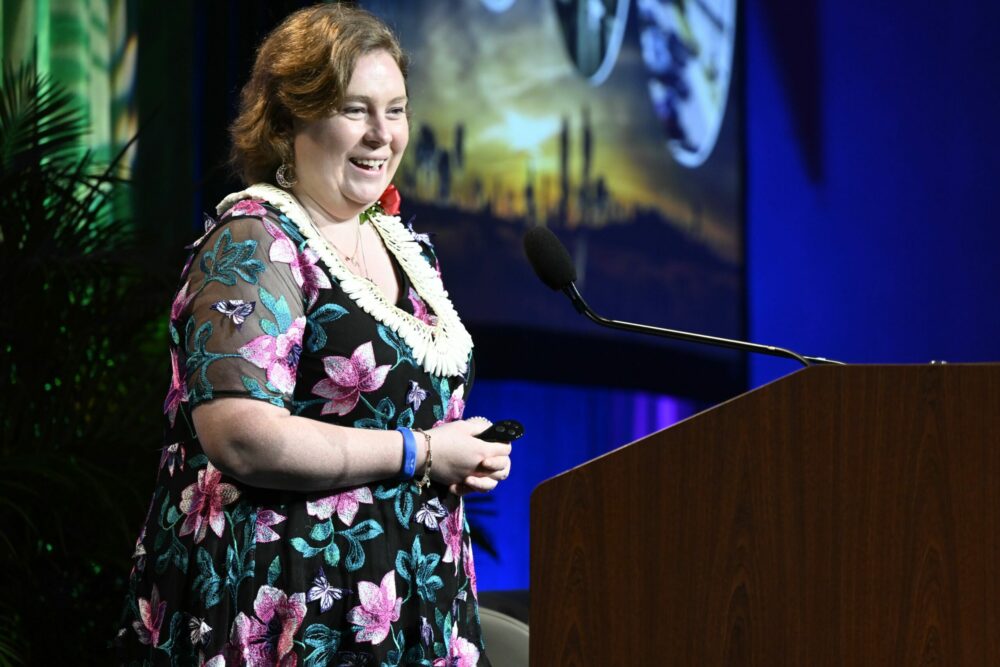
Elizabeth Pearce of Office of the CTO Australian Space Agency presented the keynote on Day 3 of AMOS 2023
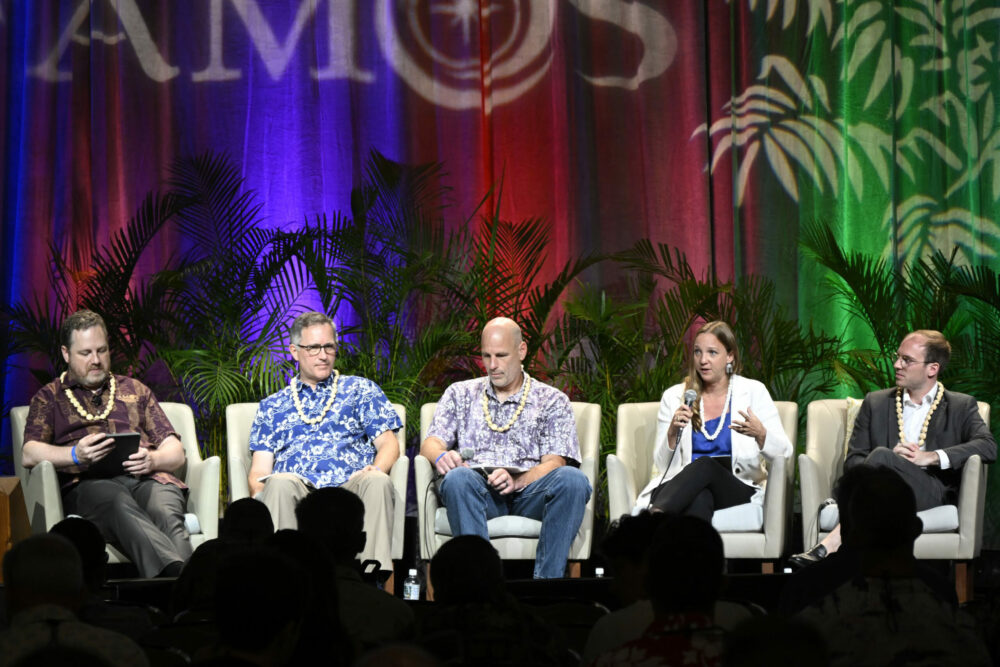
L. to R. Brian Weeden moderated the Policy Forum Panel with Daniel Oltrogge, Space Safety Coalition; David Goldstein, SpaceX; Mariel Borowitz, Office of Space Commerce; and Jerome Barbier, Paris Peace Forum.
TECHNICAL CONFERENCE
AMOS Conference received over 350 abstracts from 22 countries with 195 papers selected for oral or poster presentation. Technical sessions this year covered the topics of Astrodynamics; Atmospherics/Space Weather; Cislunar SSA; Conjunction/RPO; Machine Learning for SSA Applications; Satellite Characterization; SDA Systems & Instrumentation; Space-Based Assets; Space Debris; and Space Domain Awareness.
Session chair for the Space Debris session, James Blake commented, “As a session chair I’ve gotten to know a lot of people, gained a massive network of people that I get to come back and see every year, and it’s fantastic to read all the great content that is presented each year in the technical papers.
“AMOS 2023 was easily the most impactful conference I attended this year and in some respects the most valuable in many years,” said Stephen Fox, IERUS Technologies. “We are already excited about attending next year and are working on ideas for submission.”
AWARDS
Presented papers are peer-reviewed for publication in the 2023 Journal of Astronautical Sciences, and on the last day of the conference the American Astronautical Society (AAS) recognized outstanding efforts by presenting awards.
Best Paper for 2023 AMOS Conference was awarded to John Iannamorelli, Purdue University for his paper, “Adaptive Filtering for Multi-Sensor Maneuvering Cislunar Space Object Tracking.”
Charles Constant, University College London, was awarded the Best Student Paper Award for “Limitations of Current Practices in Uncooperative Space Surveillance: Analysis of Mega-Constellation Data Time-Series.”
TECHNICAL POSTERS
Attendees had access to the largest pool of technical posters yet, with 124 posters presented in digital format with accompanying briefings. 64 of these posters were invited for in-person presentation during the evening Poster Sessions.
Four awards were presented for Poster presentations. The Golden Ticket (Best Poster) was won by Thomas Schildknecht, Astronomisches Institut Universität Bern for “Observing and Characterizing Space Debris.” Most Creative poster is awarded to the poster with the most ambitious goal and/or most unexpected methodology to solve – this year it was presented to Darin Koblick, Raytheon for “Novel Tulip Shaped Three-body Orbits for Cislunar Space Domain Awareness Missions.”
Adrienne Rudolph, ExoAnalytic Solutions won the Newcomer Award as top poster presenting at AMOS for the first time. Her paper is “Analysis of Spacecraft Propellant Plumes in the GEO Plasma Environment.
Poster Session Chairs Darren McKnight and Matthew Stevenson, both of LeoLabs, once again hosted the Pitch Presentations. The in-person poster presenters were given the opportunity on the side-stage to give a 30-second pitch to encourage listeners to come view and hear more about their posters. This year an award was introduced to recognize the Best Poster Lightening Pitch. The inaugural award was presented to Kristin Shahady, University of North Dakota for her poster – The Future Risk of Space Debris and Contested Environment Increases the Intrinsic and Actual Cost of GEO Slots.
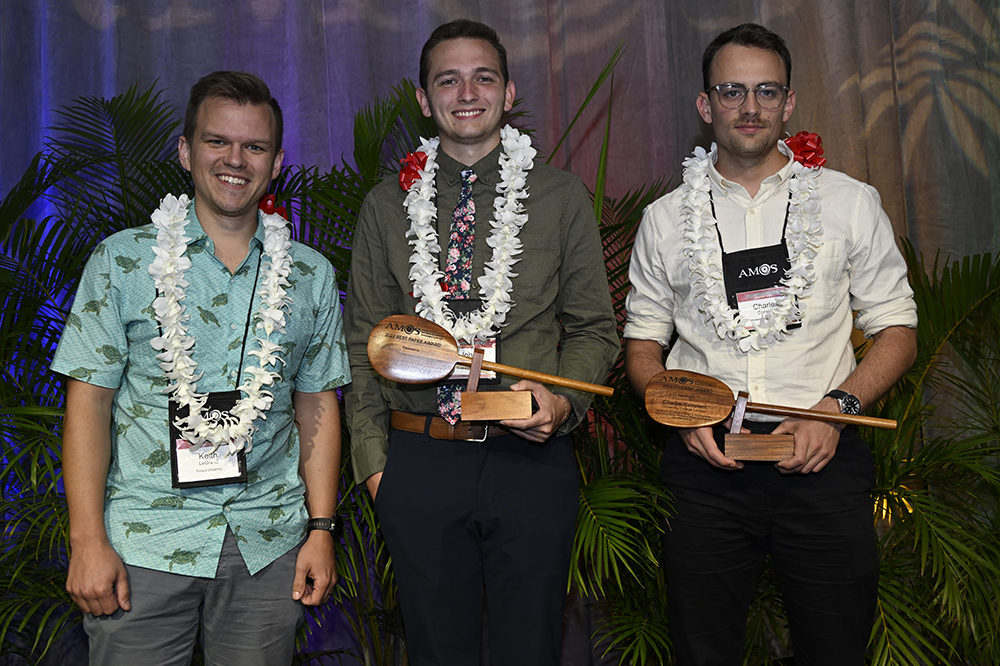
L. to R. Co-author Keith LeGrand with presenter John Iannamorelli, Best Paper Award; and Charles Constant, Best Student Paper Award.

L. to R. AMOS 2023 Poster Award winners, Kristin Shahady, Thomas Schildknecht, Darin Koblick and Adrienne Rudolph

Adrienne Rudolph, winner of Newcomer Award, presents her poster in the Exhibit Venue at AMOS 2023
INVITED/FEATURED TALKS
Each day of the 2023 AMOS program included an invited or featured presentation. Dr. Lindsay Millard, Principal Director for Space Technology, Office of the Under Secretary of Defense for Research and Engineering; spoke on Empowering Defense Space Technology Investment. Wednesday also featured a joint invited talk by Colonel Jeremy A. Raley, Director, Space Vehicles Directorate, Air Force Research Laboratory and Colonel Joseph J. Roth, Director Innovation & Prototyping Acquisition Delta and Commander, Space Systems Command Detachment 1, U.S. Space Force. The pair spoke on “How AI/ML Can Support SDA.”
Summing up the presentation, Col Raley said, “There’s specific challenges to which we need to apply this. The things where we as humans break things down into digestible segments are prime for AI to look across all those and pull in all that data to help us learn what we need to.”
“If we fail to keep up with AI we face the risk of doing nothing,” he continued. “Our risk of doing nothing is that our adversaries outperform us with that and we either end up with humans versus their rapidly evolving AI or we end up with slower AI, which is the worse situation, working against their AI who’s learning how to game ours.”
On Thursday, Colonel Raj Agrawal, Commander, Space Delta 2-Space Domain Awareness, spoke on Space Battle Management: Translating SDA into Military Options.
Dr. Kelly Hammett, Director, and Program Executive Officer for the Space Rapid Capabilities Office, spoke on Friday on Space RCO and Dynamic Space Operations.
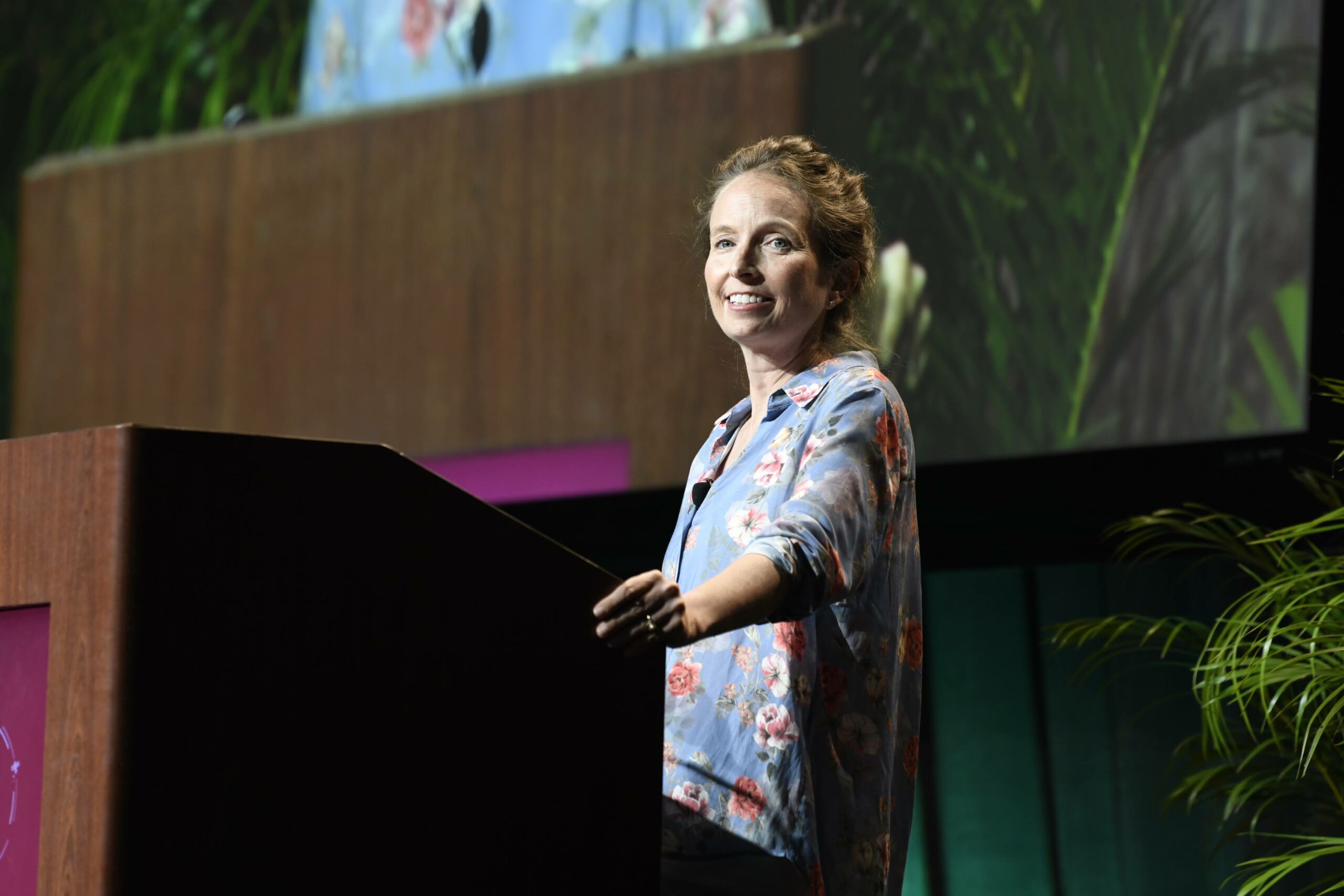
Dr. Lindsey Millard, Office of the Under Secretary of Defense for Research and Engineering, presents at AMOS 2023
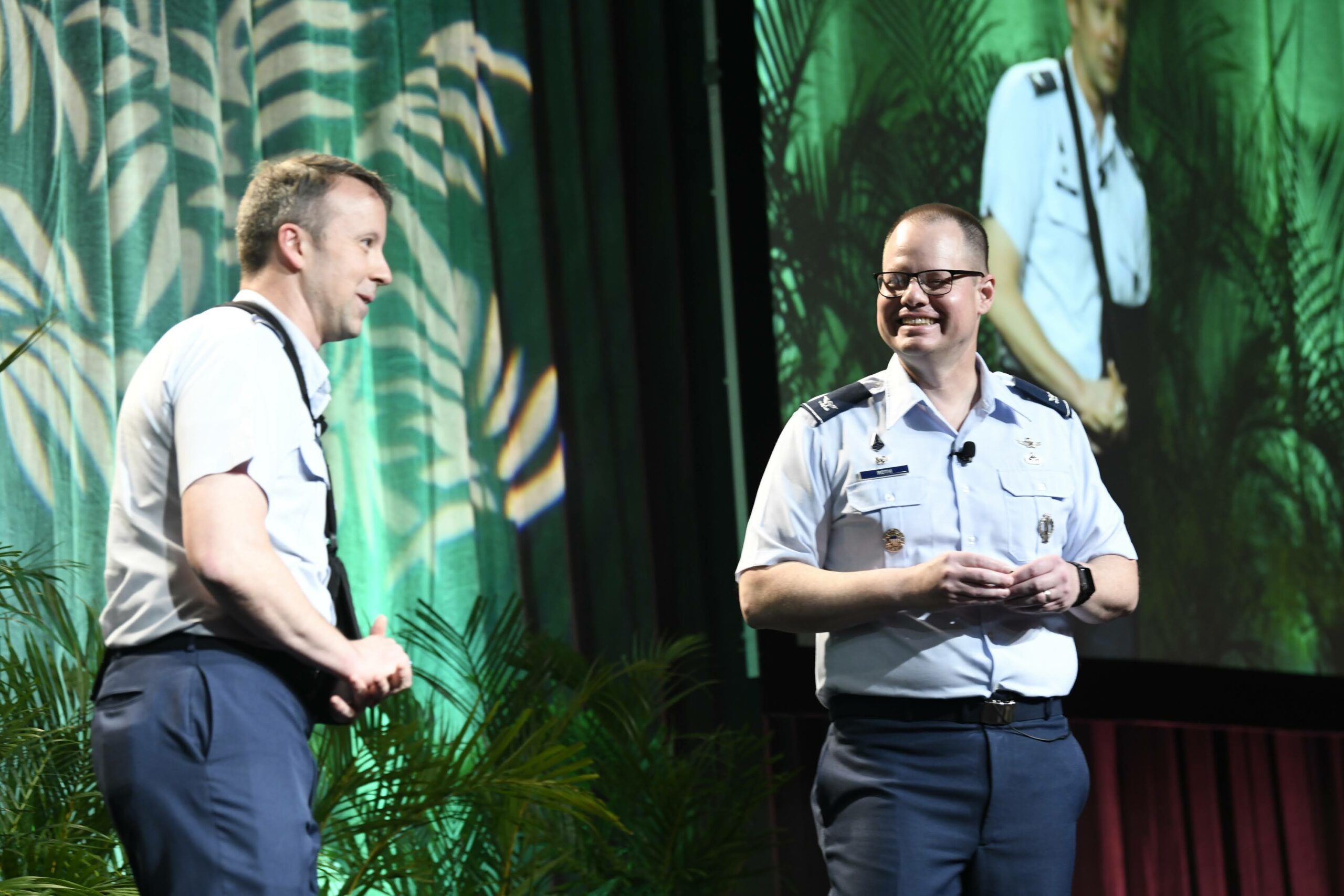
Colonel Jeremy Raley, AFRL, and Colonel Joseph Roth, U.S. Space Force spoke on AI and Machine Learning for SDA
NETWORKING
The rich program was complemented by numerous networking opportunities with breakfast and lunch included and nightly networking receptions.
On Wednesday evening the Women and Allies in Space Domain Awareness networking event was held for the second year. Dr. Janet Wolfson, Director of Science, Technology and Engineering for the Office of the Assistant Secretary of the Air Force for Space Acquisition and Integration (SAF/SQT), was the guest speaker at the reception aimed to strengthen and empower the community of women Space Domain Awareness professionals, as well as heighten the understanding of gender disparity within space-related careers.
The poster and exhibit venue was a hive of activity with exhibiting sponsors demonstrating their products and services. Exhibiting sponsors were: Advanced Scientific Concepts, Astro Haven Enterprises, Ball Aerospace, Celestron, Charles River Analytics, COMSPOC, Deloitte Consulting, Digantara, General Atomics Electromagnetic Systems, GEOST, Hart Scientific Consulting International, JHU Applied Physics Laboratory, Kayhan Space, KBR, Kratos, LeoLabs, Lipoa, Lockheed Martin, LSAS Tec, Northstar Earth & Space, Planewave Instruments, Rocket Communications, SAIC, SEAKR, Slingshot Aerospace, SpaceMap, SpaceNav, SpiderOak, Terran Orbital, TOPTICA Photonics, TransAstra.
Sponsoring, but not exhibiting, were Advanced Space, Aerospace Corporation, Anduril, Astroscale, Cloudstone Innovations, EO Solutions, ExoAnalytic Solutions, Frontgrade, GMV, L3 Harris, Linquest, NEC, Northrop Grumman, Orbital Composites, Peraton, Raytheon, Sandia National Lab, SpaceX, The Boeing Company, USRA.
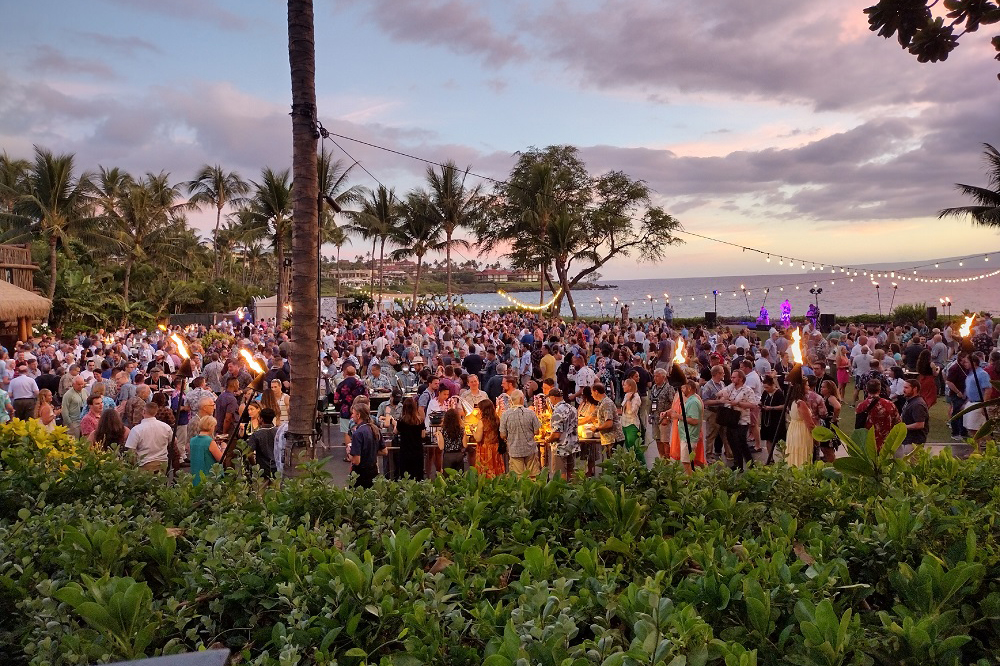
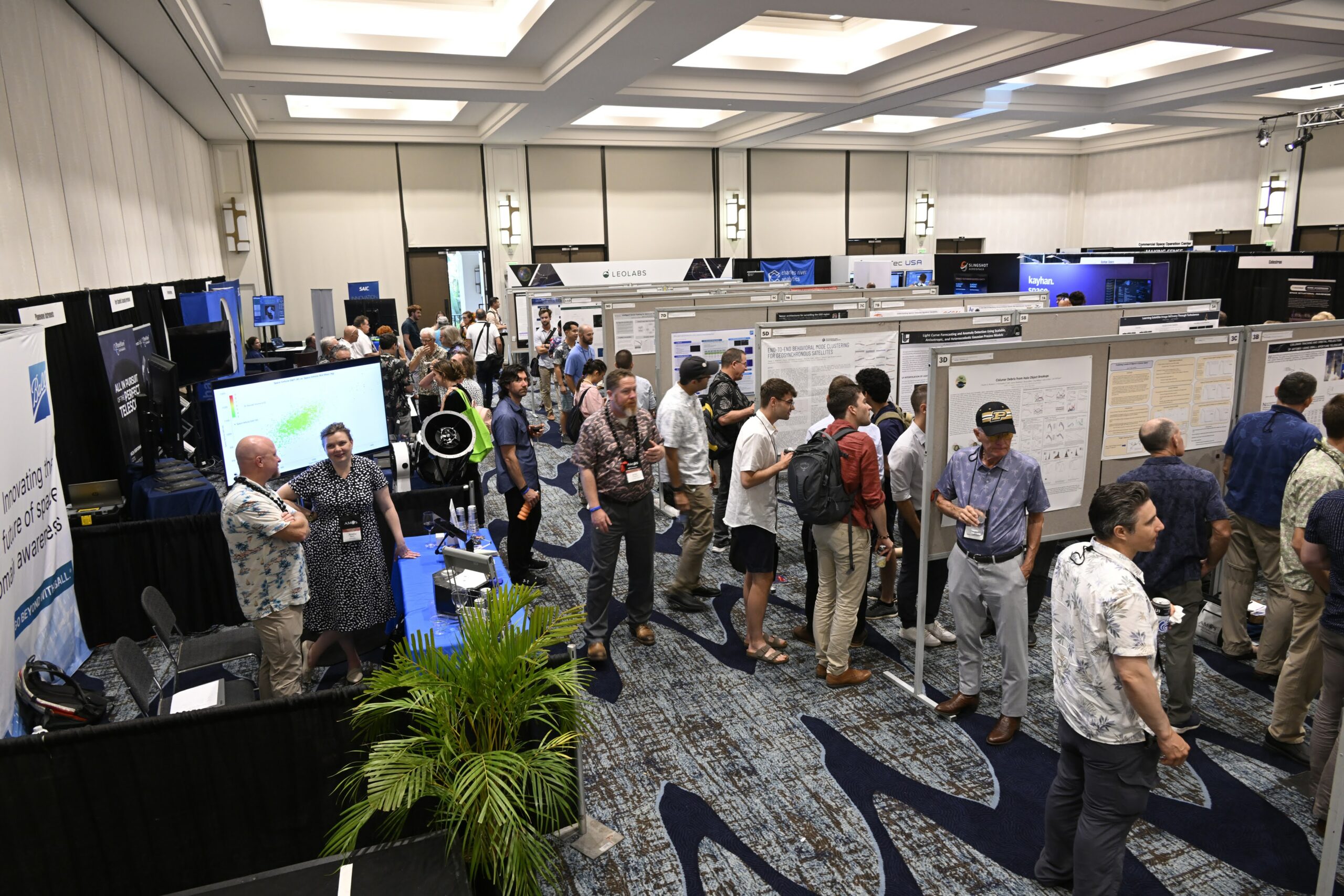

EMER-GEN® PROGRAM
The 6th EMER-GEN® program for young professionals enthusiastic about careers in space was held in the preceding days of AMOS. A joint initiative of the AMOS Conference and SGAC, the program featured professional development sessions designed to enhance the young professionals’ effectiveness in a global environment.
The main two-day EMER-GEN program featured guest speakers on The Value of Aloha, Aerospace in Hawaii, Negotiation Skills, A Policy Game (for consensus building skills) and an Innovation Challenge. Working in teams, participants were challenged to find innovative ways to make space safer to operate in, and more sustainable for long-term use.
Charles Constant said of the EMER-GEN experience, “I’ve been to a few professional development-type of events for young professionals before and this was by far the best one I’ve been to. Super smooth, very professionally organized and I’ve already felt like I’ve made friends in two days.”
Asked about his favorite session of the program, Constant said, “The one with Doug Loverro about negotiating and I think he was really just a character, and it was cool to see him in person and give his takes on things. He was really good in terms of negotiating – it helped me work with my team-mates in the Innovation challenge in getting ideas across – I tried to transfer those lessons.”
STUDENT SPACE EXPLORATION DAY
On Friday, 150 middle school students came to the conference venue for Space Exploration Day where they were treated to a presentation by astronaut Scott “Scooter” Altman followed by hands-on, space-related activities with select AMOS exhibitors and local organizations.
Wilson Chau, a Maui High School junior, said, “Meeting astronaut Scott Altman was a great experience. I am currently doing a project with the James Webb telescope and I learned so much from Mr. Altman’s talk. I am grateful for this chance to further my career .”
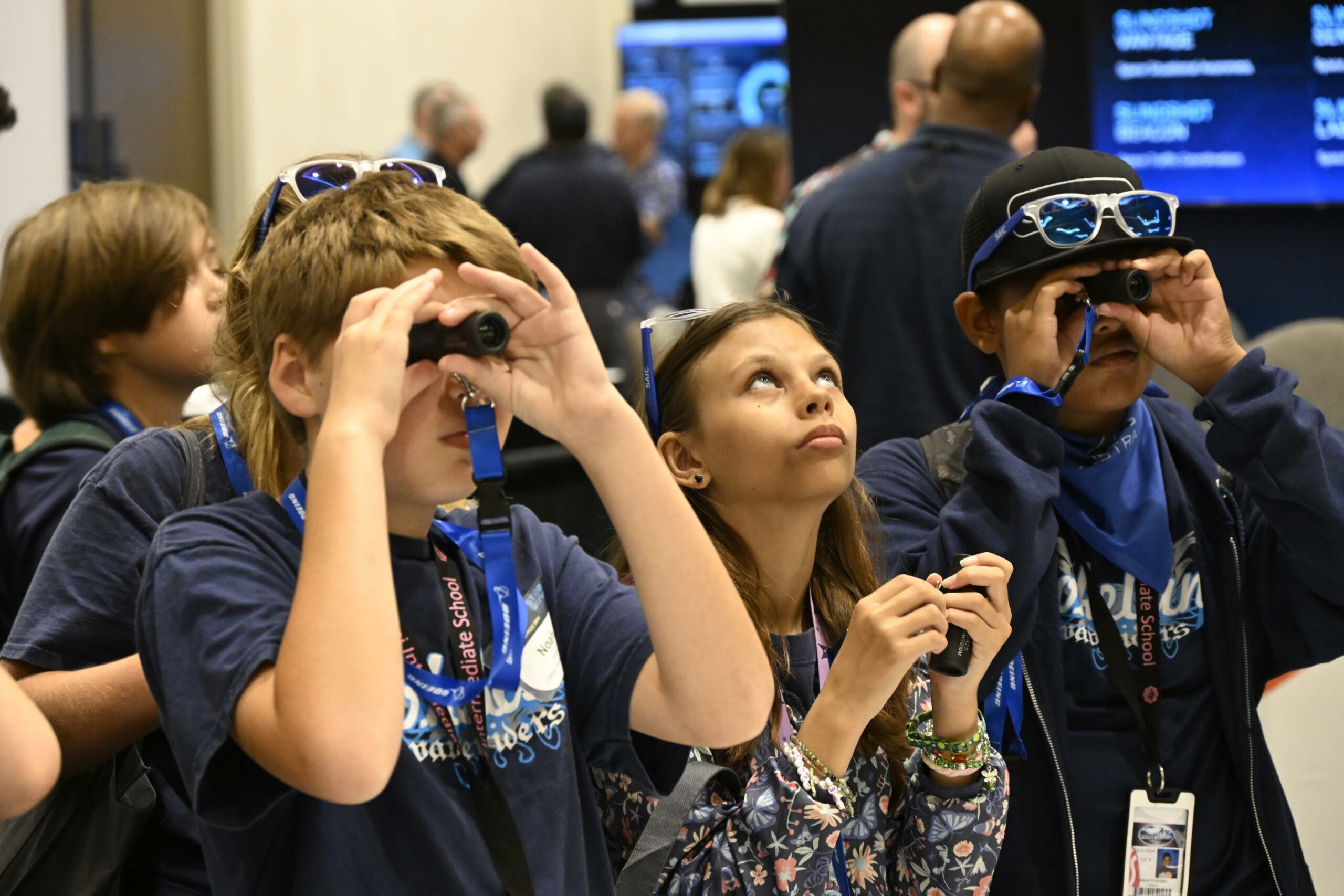
SUMMARY
“This is a fantastic opportunity to get together with all of the partners that we usually meet online,” said Liz Pearce, Australian Space Agency. “Having everyone together in one place at one time is incredibly impactful. There are key players in all of the countries represented here and I’ve met them and they now know who I am and they now have an avenue into Australia to work with us, and I now have an avenue to them…it’s groundbreaking!”
Paul Graziani, COMSPOC, who has been coming to AMOS for 20 years, commented on the tremendous growth of the AMOS Conference, “MEDB has done a phenomenal job of growing this conference to the point where it’s busting at the seams. It’s always been an incredibly valuable conference for anyone in space situational awareness and that has been an important part of how we have progressed over the past several years.”
“There’s a couple of takeaways for me, when I compare it to the last time I was here 10 years ago,” said Audrey Schaffer, Vice President, Strategy and Policy with Slingshot. “One — the growing demand for events focused on space domain awareness and related fields. This industry has grown, both on the government side as well as the corporate side. The other takeaway for me is how well the conference has done in maintaining a good balance between technical and policy. To see that the policy side has sustained and grown in the last 10 years without impacting the robust technical conversations, I think is truly unique.”
The AMOS Conference and EMER-GEN are presented by the Maui Economic Development Board, Inc. (MEDB), a nonprofit corporation established in 1982 to focus on diversifying Maui’s economy. MEDB’s mission involves taking innovative actions that strengthen existing industry as well as diversifying through new opportunities. Save the date for 2024 – September 17-20 with EMER-GEN Program on September 15-17.
